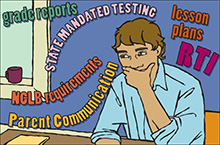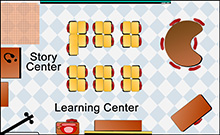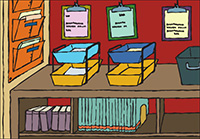How can Mr. Brewster and the other school professionals at Rosa Parks Elementary School prepare to implement RTI?
Page 2: Before School Starts
 Although he recognizes the value of RTI, Mr. Brewster wonders how he can coordinate and implement all of its components in addition to everything else he needs to fit into his busy schedule. After speaking with Mrs. Hernandez and the other first-grade teachers who piloted RTI last year, Mr. Brewster realizes that with careful organization, he can implement RTI without taking a lot of time away from his other responsibilities.
Although he recognizes the value of RTI, Mr. Brewster wonders how he can coordinate and implement all of its components in addition to everything else he needs to fit into his busy schedule. After speaking with Mrs. Hernandez and the other first-grade teachers who piloted RTI last year, Mr. Brewster realizes that with careful organization, he can implement RTI without taking a lot of time away from his other responsibilities.
Listen as Thea Woodruff discusses the importance of teachers’ planning and organizing for the school year (time: 0:44).

Thea Woodruff, PhD
Director, Professional Development and Technical Assistance Teams,
Vaughn Gross Center’s Reading First Project
University of Texas, Austin
Transcript: Thea Woodruff, PhD
One of the things that teachers struggle with a lot of times, before school even starts, is really organizing and preparing themselves. And what I mean by that is doing even very basic things like organizing the classroom, setting up a classroom-management system, thinking ahead of time about their behavior-management system, how they’re going to put all those things in place ahead of time. Planning up front can really make a big difference in the efficiency and effectiveness of how the rest of the school year’s gonna go. Teachers are so rushed at the beginning of school to do a lot of different things, the preparation up front, a lot of times, falls by the way side, but if you can plan up front, it makes a huge difference.
Mr. Brewster decides to use the two-week period before school begins to prepare and organize. He chooses to address the following items:
- Core reading program
- Student information
- Classroom arrangement
- Materials storage
- Data management system
- Classroom management system
- Daily schedule
Core Reading Program
 It is important for a teacher to know whether the core reading program used by the school is comprehensive and provides adequate instruction for the five core components of reading:
It is important for a teacher to know whether the core reading program used by the school is comprehensive and provides adequate instruction for the five core components of reading:
Phonemic awareness
The ability to listen, identify, and manipulate phonemes—the smallest units of sounds that are combined to create words.
Phonics and word study
A method of reading in which students are taught the relationship between sounds and written letters. In word study instruction, students learn to use the complex elements of reading to decode more advanced words (e.g., students learn how to decode words based on associated word meanings and by learning how to identify word parts, such as affixes and root words); the combination of phonics and word study helps students with word recognition, reading, and spelling.
Vocabulary
The words known by a person; a knowledge of words and what they mean. Students learn vocabulary through a variety of contexts such as talking, interacting, and playing with others; listening to stories; watching TV; and attending school.
Fluency
The ability to read text with accuracy, speed, and intonation.
Comprehension
The ability to understand written text.
It is also important to determine whether the reading program contains culturally relevant materials and is accessible for students with disabilities. Should the program lack these components or if they are not sufficient, it is crucial that the teacher enhance his or her instruction with additional materials.
 Analyzing the core reading program may be a time-intensive and demanding task. One of the most comprehensive methods of analyzing a reading program is using the Consumer’s Guide to Evaluating a Core Reading Program. To make this task more manageable, the process can be divided among the teachers at a given grade level. Additionally, if time is limited, teachers might want to examine student data from the previous year to determine in what areas students seemed to have the most difficulty. They can analyze that component first to judge whether additional resources are needed.
Analyzing the core reading program may be a time-intensive and demanding task. One of the most comprehensive methods of analyzing a reading program is using the Consumer’s Guide to Evaluating a Core Reading Program. To make this task more manageable, the process can be divided among the teachers at a given grade level. Additionally, if time is limited, teachers might want to examine student data from the previous year to determine in what areas students seemed to have the most difficulty. They can analyze that component first to judge whether additional resources are needed.
 For example, Mr. Brewster and the other second-grade teachers examine their students’ achievement test scores from the previous year and decide that vocabulary was a problematic area for many of them. With that knowledge, they use the Consumer’s Guide to analyze the vocabulary elements of their reading curriculum. After analyzing the vocabulary section of the core program, the second-grade team selects additional resources to enhance the core program. Mr. Brewster also decides to create a learning center that focuses on vocabulary instruction.
For example, Mr. Brewster and the other second-grade teachers examine their students’ achievement test scores from the previous year and decide that vocabulary was a problematic area for many of them. With that knowledge, they use the Consumer’s Guide to analyze the vocabulary elements of their reading curriculum. After analyzing the vocabulary section of the core program, the second-grade team selects additional resources to enhance the core program. Mr. Brewster also decides to create a learning center that focuses on vocabulary instruction.
Student Information
If the teacher has a list of the students in his or her classroom, he or she would benefit from collecting information (e.g., last year’s test scores or data, who requires an accommodation, what interventions were used) for structuring the physical or learning environment.
 At Rosa Parks, the principal makes certain that teachers have a working class roster two weeks before school begins. Mr. Brewster reviews this list and collects information about his students. He discovers that three of his students (DeJuan, LaToya, and Jack) received Tier 2 intervention last year, and one of them (DeJuan) discontinued the additional support after one round (10 weeks) of intervention. Mr. Brewster will consider this information as he goes about creating groups.
At Rosa Parks, the principal makes certain that teachers have a working class roster two weeks before school begins. Mr. Brewster reviews this list and collects information about his students. He discovers that three of his students (DeJuan, LaToya, and Jack) received Tier 2 intervention last year, and one of them (DeJuan) discontinued the additional support after one round (10 weeks) of intervention. Mr. Brewster will consider this information as he goes about creating groups.
| First Name | Notes |
| Niklas | |
| Leoni | |
| LaToya | Received multiple rounds of Tier 2 last year |
| Caroline | |
| Misty | ADHD |
| DeJuan | 1 round of Tier 2 at the beginning of the year |
| Jack | After receiving 1 round of Tier 2, he was identified as having LD; has a current IEP |
| Paloma | Attended ESL class |
| Casey | |
| Sammy | ADHD; In 1st grade, returned to Tier 1 after one round of Tier 2 intervention in the fall, then later received Tier 2 again in the spring |
| Benika | |
| Laney | Received Tier 2 intervention only in the spring |
| Jenny | Missed a lot of school due to asthma |
| Jaye | |
| Caleb | Lives with a foster parent |
| John | |
| Hannah | |
| Susie | Profound hearing loss; reads lips |
| Teri | |
| Twyla | Reading at a 4th-grade level |
| Irina | |
| Alfredo | Reading at a 5th-grade level |
| Adam | New student, transfer from New Orleans, records haven’t arrived yet |
| Harris | Needs accommodations for a wheelchair |
Classroom Arrangement
 During his inspection of student information on his incoming students, Mr. Brewster discovers that one student will be in a wheelchair. This in mind, he arranges his room so the student will be able to move about access materials with ease. He also acquires a desk that can accommodate the student’s wheelchair.
During his inspection of student information on his incoming students, Mr. Brewster discovers that one student will be in a wheelchair. This in mind, he arranges his room so the student will be able to move about access materials with ease. He also acquires a desk that can accommodate the student’s wheelchair.
When they arrange their classrooms, teachers should make certain that the seating arrangement accommodates whole-group instruction, small-group instruction, and small-group or independent work in centers. It is also important to keep in mind that high-traffic areas (e.g., by the pencil sharpener and the trash can) should be arranged to avoid congestion and to minimize distraction. For more information on this topic, view the IRIS Case Study “Effective Room Arrangement.”
Materials Storage
 By organizing their materials, teachers can more easily and effectively implement the RTI process. Some materials, such as the universal screening and the progress monitoring probes and score sheets, should be easily accessible to the teacher. However, if the students are graphing their own data, the teacher might designate a special place for the students to turn in their materials after each assessment. Additionally, teachers should organize a system and specify a consistent place for students to turn in the work they have completed at the various instructional centers.
By organizing their materials, teachers can more easily and effectively implement the RTI process. Some materials, such as the universal screening and the progress monitoring probes and score sheets, should be easily accessible to the teacher. However, if the students are graphing their own data, the teacher might designate a special place for the students to turn in their materials after each assessment. Additionally, teachers should organize a system and specify a consistent place for students to turn in the work they have completed at the various instructional centers.
Data Management System
There are a number of methods for keeping track of students’ data. Commercial companies that develop and sell progress monitoring tools typically offer Web-based programs that allow teachers to enter each student’s data and that provide individual and classroom graphs and reports. Alternatively, schools or teachers may decide to develop their own data management systems using a computer spreadsheet program. In either case, the data management system should be easily accessible, as teachers frequently need to monitor their students’ progress.
The Teacher’s Materials Center ![]() (below) links to helpful resources for tracking and graphing progress monitoring data, including a downloadable data management program and blank graph paper. It also includes a tool that allows students to create and print individualized graphs. Research shows that students who graph their own progress monitoring data are more aware of their performance and consider themselves more responsible for their own learning.
(below) links to helpful resources for tracking and graphing progress monitoring data, including a downloadable data management program and blank graph paper. It also includes a tool that allows students to create and print individualized graphs. Research shows that students who graph their own progress monitoring data are more aware of their performance and consider themselves more responsible for their own learning.
Classroom Management System
 Teachers who establish and maintain effective classroom rules are more likely to prevent potential behavior problems and disruption during instruction. It is important for teachers to establish clear expectations so that students will know what is expected of them. To learn more about developing a classwide behavior management plan, view the following Modules:
Teachers who establish and maintain effective classroom rules are more likely to prevent potential behavior problems and disruption during instruction. It is important for teachers to establish clear expectations so that students will know what is expected of them. To learn more about developing a classwide behavior management plan, view the following Modules:
- Classroom Behavior Management (Part 1): Key Concepts and Foundational Practices
- Classroom Behavior Management (Part 2, Elementary): Developing a Behavior Management Plan
Daily Schedule
Although some extracurricular classes (e.g., P.E., music) and lunch may be scheduled by the administration, the teacher should make sure to include the following in the daily schedule:
-
-
-
- 90 minutes of core reading instruction each day
- Tier 2 and Tier 3 intervention time (whether provided by the classroom teacher or another individual)
- Frequent progress monitoring
-
-
Daily scheduling considerations for RTI reading instruction should be balanced with the time requirements of other subjects (e.g., math, social studies, science) and “specials” (e.g., music, P.E., art). Teachers should take care when scheduling routine events (e.g., verifying attendance, taking lunch count, traveling to and from lunch or recess) to avoid wasted instructional time. The combination of purposeful planning and good execution can help teachers to minimize lost time during the school day.

